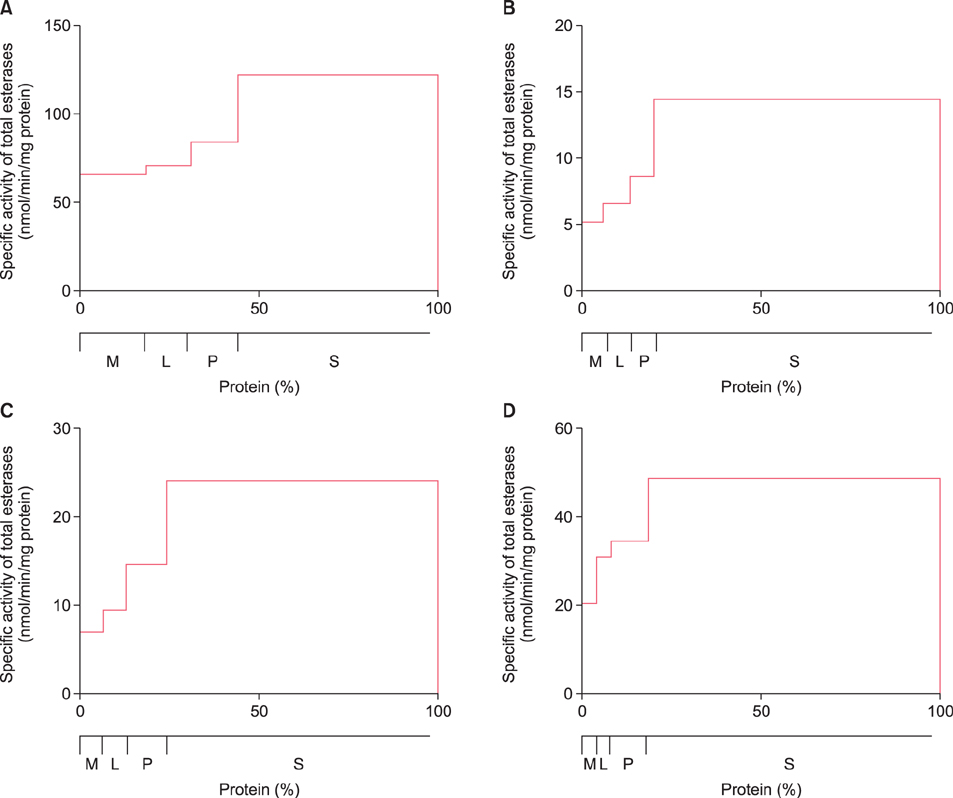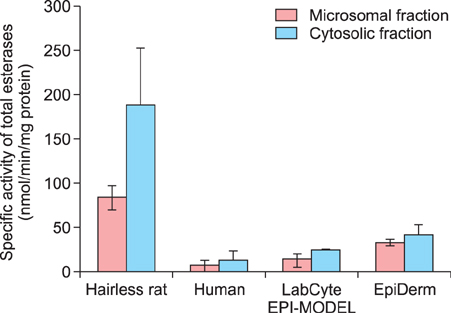Ann Dermatol.
2015 Jun;27(3):269-274. 10.5021/ad.2015.27.3.269.
Esterase Activity and Intracellular Localization in Reconstructed Human Epidermal Cultured Skin Models
- Affiliations
-
- 1Laboratory of Dermatological Physiology, Faculty of Pharmaceutical Sciences, Josai University, Sakado, Japan. tokudome@josai.ac.jp
- KMID: 2352497
- DOI: http://doi.org/10.5021/ad.2015.27.3.269
Abstract
- BACKGROUND
Reconstructed human epidermal culture skin models have been developed for cosmetic and pharmaceutical research.
OBJECTIVE
This study evaluated the total and carboxyl esterase activities (i.e., K(m) and V(max), respectively) and localization in two reconstructed human epidermal culture skin models (LabCyte EPI-MODEL [Japan Tissue Engineering] and EpiDerm [MatTek/Kurabo]). The usefulness of the reconstruction cultured epidermis was also verified by comparison with human and rat epidermis.
METHODS
Homogenized epidermal samples were fractioned by centrifugation. p-nitrophenyl acetate and 4-methylumbelliferyl acetate were used as substrates of total esterase and carboxyl esterase, respectively.
RESULTS
Total and carboxyl esterase activities were present in the reconstructed human epidermal culture skin models and were localized in the cytosol. Moreover, the activities and localization were the same as those in human and rat epidermis.
CONCLUSION
LabCyte EPI-MODEL and EpiDerm are potentially useful for esterase activity prediction in human epidermis.
Keyword
Figure
Reference
-
1. Satoh T, Hosokawa M. The mammalian carboxylesterases: from molecules to functions. Annu Rev Pharmacol Toxicol. 1998; 38:257–288.
Article2. Jewell C, Ackermann C, Payne NA, Fate G, Voorman R, Williams FM. Specificity of procaine and ester hydrolysis by human, minipig, and rat skin and liver. Drug Metab Dispos. 2007; 35:2015–2022.
Article3. Müller B, Kasper M, Surber C, Imanidis G. Permeation, metabolism and site of action concentration of nicotinic acid derivatives in human skin. Correlation with topical pharmacological effect. Eur J Pharm Sci. 2003; 20:181–195.
Article4. Winkelmann RK, Schmit RW. Cholinesterase in the skin of the rat, dog, cat, guinea pig and rabbit. J Invest Dermatol. 1959; 33:185–190.5. McCracken NW, Blain PG, Williams FM. Nature and role of xenobiotic metabolizing esterases in rat liver, lung, skin and blood. Biochem Pharmacol. 1993; 45:31–36.
Article6. McCracken NW, Blain PG, Williams FM. Human xenobiotic metabolizing esterases in liver and blood. Biochem Pharmacol. 1993; 46:1125–1129.
Article7. Clark NW, Scott RC, Blain PG, Williams FM. Fate of fluazifop butyl in rat and human skin in vitro. Arch Toxicol. 1993; 67:44–48.
Article8. Mutch E, Nave R, McCracken N, Zech K, Williams FM. The role of esterases in the metabolism of ciclesonide to desisobutyryl-ciclesonide in human tissue. Biochem Pharmacol. 2007; 73:1657–1664.
Article9. Dean RA, Christian CD, Sample RH, Bosron WF. Human liver cocaine esterases: ethanol-mediated formation of ethylcocaine. FASEB J. 1991; 5:2735–2739.
Article10. Zhang J, Burnell JC, Dumaual N, Bosron WF. Binding and hydrolysis of meperidine by human liver carboxylesterase hCE-1. J Pharmacol Exp Ther. 1999; 290:314–318.11. Alexson SE, Diczfalusy M, Halldin M, Swedmark S. Involvement of liver carboxylesterases in the in vitro metabolism of lidocaine. Drug Metab Dispos. 2002; 30:643–647.
Article12. Ettmayer P, Amidon GL, Clement B, Testa B. Lessons learned from marketed and investigational prodrugs. J Med Chem. 2004; 47:2393–2404.
Article13. Boehnlein J, Sakr A, Lichtin JL, Bronaugh RL. Characterization of esterase and alcohol dehydrogenase activity in skin. Metabolism of retinyl palmitate to retinol (vitamin A) during percutaneous absorption. Pharm Res. 1994; 11:1155–1159.14. Crespi HG. Topical corticosteroid therapy for children: alclometasone dipropionate cream 0.05%. Clin Ther. 1986; 8:203–210.15. Van Gelder J, Shafiee M, De Clercq E, Penninckx F, Van den Mooter G, Kinget R, et al. Species-dependent and site-specific intestinal metabolism of ester prodrugs. Int J Pharm. 2000; 205:93–100.
Article16. Prusakiewicz JJ, Ackermann C, Voorman R. Comparison of skin esterase activities from different species. Pharm Res. 2006; 23:1517–1524.
Article17. Bätz FM, Klipper W, Korting HC, Henkler F, Landsiedel R, Luch A, et al. Esterase activity in excised and reconstructed human skin--biotransformation of prednicarbate and the model dye fluorescein diacetate. Eur J Pharm Biopharm. 2013; 84:374–385.
Article18. Lowry OH, Rosebrough NJ, Farr AL, Randall RJ. Protein measurement with the Folin phenol reagent. J Biol Chem. 1951; 193:265–275.
Article19. Prausnitz MR, Bose VG, Langer R, Weaver JC. Electroporation of mammalian skin: a mechanism to enhance transdermal drug delivery. Proc Natl Acad Sci U S A. 1993; 90:10504–10508.
Article20. Bhatt RH, Micali G, Galinkin J, Palicharla P, Koch RL, West DP, et al. Determination and correlation of in vitro viability for hairless mouse and human neonatal whole skin and stratum corneum/epidermis. Arch Dermatol Res. 1997; 289:170–173.
Article21. Obata Y, Utsumi S, Watanabe H, Suda M, Tokudome Y, Otsuka M, et al. Infrared spectroscopic study of lipid interaction in stratum corneum treated with transdermal absorption enhancers. Int J Pharm. 2010; 389:18–23.
Article22. Gupta JD, Gupta V. Serum aspirin esterase activity in women with habitual aspirin intake. Clin Chim Acta. 1977; 81:261–265.
Article23. Rainsford KD, Ford NL, Brooks PM, Watson HM. Plasma aspirin esterases in normal individuals, patients with alcoholic liver disease and rheumatoid arthritis: characterization and the importance of the enzymic components. Eur J Clin Invest. 1980; 10:413–420.
Article
- Full Text Links
- Actions
-
Cited
- CITED
-
- Close
- Share
- Similar articles
-
- Growth of Human Melanocytes in Human Epidermis Reconstructed by Culture
- Radioprotective effects of dimethyl sulfoxide in the artificial skin reconstructed with cultured human cells
- Expression of Epidermal Protein Antigens and Basement Membrane Components in Human Epidermis Reconstructed by Culture
- Production of ETAF from Human Epidermal Cells
- The Effect of Supernatant from UVB - Irradiated Cultured Keratinocytes on the Growth , Melanin Content , and Tyrosinase Activity of Human Melanocyte





